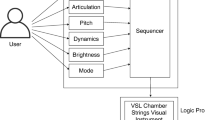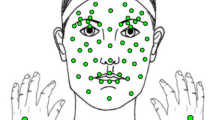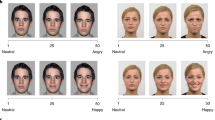Abstract
This paper proposes and explores an abstract approach to express emotions. Emotions are represented in terms of valence and arousal dimensions and they are visually expressed through the shape and speed of a series of concatenated digital shifting curves that together compose a curved line that resembles a non-periodic wave. In particular, the valence value is expressed through the sharpness of the curves (the more negative the valence, the sharper the curves), while the arousal value is expressed through their height, width and speed (the greater the arousal, the higher, thinner and quicker the curves). Furthermore, the paper describes a user experiment which investigated whether the valence and arousal expressed by our model are appropriately perceived by the users or not. The results suggest that combinations of sharpness, height, width and speed are perceived correctly as particular emotions; that sharpness is perceived as valence; that height, width and speed are jointly perceived as arousal; and that the perceptions of both valence and arousal are independent of each other.
Access this chapter
Tax calculation will be finalised at checkout
Purchases are for personal use only
Preview
Unable to display preview. Download preview PDF.
Similar content being viewed by others
References
André, P., Schraefel, M.C., Dix, A., White, R.W.: Experience in social affective applications: methodologies and case study. In: 2010: Proceedings of the 28th of the International Conference Extended Abstracts on Human Factors in Computing Systems, pp. 2755–2764. ACM, New York (2010)
Aronoff, J., Woike, B.A., Hyman, L.M.: Which are the stimuli in facial displays of anger and happiness? configurational bases of emotion recognition. Journal of Personality and Social Psychology 62(6), 1050–1066 (1992)
Bar, M., Neta, M.: Humans prefer curved visual objects. Psychological Science 17(8), 645–648 (2006)
Bar, M., Neta, M.: Visual elements of subjective preference modulate amygdala activation. Neuropsychologia 45(10), 2191–2200 (2007)
Bialoskorski, L.S.S., Westerink, J.H.D.M., Van Den Broek, E.L.: Mood swings: Design and evaluation of affective interactive art. New Rev. Hypermedia Multimedia 15(2), 173–191 (2009)
Dehn, D.M., van Mulken, S.: The impact of animated interface agents: A review of empirical research. International Journal of Human-Computer Studies 52(1), 1–22 (2000)
Dey, A.K., de Guzman, E.: From awareness to connectedness: The design and deployment of presence displays. In: CHI 2006: Proceedings of the SIGCHI Conference on Human Factors in computing Systems, pp. 899–908. ACM Press (2006)
Halper, N., Mellin, M., Herrmann, C.S., Linneweber, V., Strothotte, T.: Towards an understanding of the psychology of non-photorealistic rendering. In: Jochen Schneider, T.S., Marotzki, W. (eds.) Proc. Workshop Computational Visualistics, Media Informatics and Virtual Communities, pp. 67–78. Deutscher Universitäts-Verlag (April 2003)
Hevner, K.: Experimental studies of the affective value of colors and lines. Journal of Applied Psychology 19(4), 385–398 (1935)
Ibáñez, J.: Minimalist approach to show emotions via a flock of smileys. Journal of Network and Computer Applications 34, 1283–1291 (2011)
Ibáñez, J.: Showing emotions through movement and symmetry. Computers in Human Behavior 27, 561–567 (2011)
Ibáñez, J.: Emotional clouds: Showing arousal and valence through the movement and darkness of digital cartoonish clouds. Int. J. Hum.-Comput. Stud. 71(10), 967–977 (2013)
Ibáñez, J.: Emotional sea: Showing valence and arousal through the sharpness and movement of digital cartoonish sea waves. IEEE Transactions on Systems, Man, and Cybernetics: Systems 43(4), 901–910 (2013)
Ibáñez, J., Delgado-Mata, C., Gómez-Caballero, F.: A novel approach to express emotions through a flock of virtual beings. In: CW 2007: Proceedings of the 2007 International Conference on Cyberworlds, pp. 241–248. IEEE Computer Society (2007)
Ibáñez, J., Serrano, O., García, D.: Emotinet: A framework for the development of social awareness systems. In: Awareness Systems. Human-Computer Interaction Series, pp. 291–311. Springer, London (2009)
Jancke, G., Grudin, J., Gupta, A.: Presenting to local and remote audiences: Design and use of the telep system. In: Proceedings of the SIGCHI Conference on Human Factors in Computing Systems, pp. 384–391. ACM Press (2000)
Kok, R., Broekens, J.: Physical emotion induction and its use in entertainment: Lessons learned. In: Ciancarini, P., Nakatsu, R., Nakatsu, R., Roccetti, M. (eds.) New Frontiers for Entertainment Computing. IFIP, vol. 279, pp. 33–48. Springer, Boston (2008)
Lang, P.J.: Behavioral treatment and bio-behavioral assessment: Computer applications. In: Sidowski, J.B., Johnson, J.H., Williams, T.A. (eds.) Technology in Mental Health Care Delivery Systems, pp. 119–137. Ablex Pub, Norwood (1980)
Leder, H., Carbon, C.-C.: Dimensions in appreciation of car interior design. Applied Cognitive Psychology 19(5), 603–618 (2005)
Lundholm, H.: The affective tone of lines: Experimental researches. Psychological Review 28(1), 43–60 (1921)
Markopoulos, P., de Ruyter, B., Mackay, W.E.: Awareness systems: known results, theory, concepts and future challenges. In: CHI 2005: Extended Abstracts on Human Factors in Computing Systems, pp. 2128–2129. ACM Press (2005)
McCloud, S.: Understanding comics: The invisible art. Harper Paperbacks (1994)
Monö, R.: Design for product understanding: the aesthetics of design from a semiotic approach. Liber, Stockholm (1997)
Oatley, K., Johnson-Laird, P.N.: Towards a cognitive theory of emotions. Cognition and Emotion 1(1), 29–50 (1987)
Poffenberger, A.T., Barrows, B.E.: The feeling value of lines. Journal of Applied Psychology 8(2), 187–205 (1924)
Russell, J.A.: A circumplex model of affect. Journal of Personality and Social Psychology 39(6), 1161–1178 (1980)
Silvia, P.J., Barona, C.M.: Do people prefer curved objects? angularity, expertise, and aesthetic preference. Empirical Studies of the Arts 27(1), 25–42 (2009)
Wallbott, H.G.: Bodily expression of emotion. European Journal of Social Psychology 28(6), 879–896 (1998)
Wundt, W.: Grundriss der psychologie. Engelmann, Leipzig (1896)
Zebrowitz, L.: Reading faces: Window to the soul?. Westview Press (1997)
Author information
Authors and Affiliations
Editor information
Editors and Affiliations
Rights and permissions
Copyright information
© 2014 Springer International Publishing Switzerland
About this paper
Cite this paper
Ibáñez, J., Delgado-Mata, C. (2014). Emotional Line: Showing Emotions through the Sharpness, Height, Width and Speed of a Series of Concatenated Digital Shifting Curves. In: Christie, M., Li, TY. (eds) Smart Graphics. SG 2014. Lecture Notes in Computer Science, vol 8698. Springer, Cham. https://doi.org/10.1007/978-3-319-11650-1_9
Download citation
DOI: https://doi.org/10.1007/978-3-319-11650-1_9
Publisher Name: Springer, Cham
Print ISBN: 978-3-319-11649-5
Online ISBN: 978-3-319-11650-1
eBook Packages: Computer ScienceComputer Science (R0)




